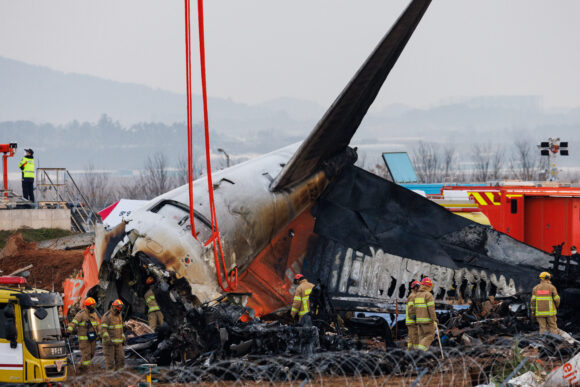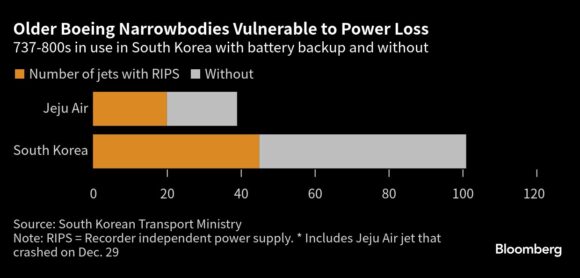The investigation into South Korea’s recent deadly plane crash has underscored a shortcoming first identified more than two decades ago — that older aircraft lack the technology to keep the cockpit voice recorder working when the main power sources fail.
Both the flight data and the cockpit voice recorders on the Boeing Co. 737-800 operated by Jeju Air Co. switched off four minutes before the plane barreled into a concrete structure at the end of a runway at Muan International Airport on Dec. 29, the Korean Transport ministry has said. Authorities suspect that both engines shut down shortly before the pilot attempted an emergency landing, depriving the aircraft of almost all electrical power in its final moments before impact.
The discovery is a major setback for the team trying to unravel the mystery of how the disaster occurred. It also brings to the forefront one significant shortcoming of older planes. Cockpit voice recorders on all new aircraft must have a backup power source that can keep them working for about 10 minutes after main power fails, a system that many older planes lack and didn’t have to be equipped with retroactively.
The absence of a transcript of the final moments leaves the investigation without crucial clues that would likely have shed more light on what caused the catastrophe. On-the-ground footage of the jet before landing suggests that one engine may have flamed out after a bird strike, but the condition of the second one isn’t known.
The pilot didn’t extend the landing gear when he touched down, or the wing flaps and slats that would have helped slow the plane down. Both systems receive power as long as one engine is running. Instead, the plane charged into the concrete wall on its belly at high speed, killing almost everyone on board.
Modern aircraft have two recording devices: The cockpit voice recorder, or CVR, and a second one commonly referred to as the FDR for flight data that stores aircraft systems and inputs. The US National Transportation Safety Board first recommended that CVRs be fitted with an independent power source in the late 1990s. The board also advocated for older planes to be retrofitted with the new capability, but the Federal Aviation Administration has said the cost to operators would be too high.
The NTSB later accepted the FAA’s approach. The US published a final rule requiring new aircraft be equipped with a backup power source for CVRs in 2008, with manufacturers having to comply by April 2010, though several asked for extensions.
The flight data and cockpit voice recorders “are critical to finding out about the health of the aircraft before the crash and the decision making by the crew,” said Hassan Shahidi, president and chief executive officer of the Flight Safety Foundation. “If it turns out that the reason for the recorders not working was loss of power, then clearly this is cause for reevaluating the 2008 decision.”
The Boeing 737 involved in the deadly crash was first delivered to Irish discount carrier Ryanair Holdings Plc in 2009. That was shortly before the new voice-recorder requirements kicked in.
A black box missing data in an aviation accident is very rare, Joo Jong-wan, a senior official at the Korean transport ministry, said at a hearing held by lawmakers in Seoul on Tuesday.
The pilot of the Jeju Air jet also may have failed to turn on the aircraft’s auxiliary power unit that would have kept the CVR and FDR running, Yoo Kyeong-soo, a director-general at the Korean transport ministry, told lawmakers at the hearing.
More than half of the 101 Boeing 737-800 jets currently flying in Korea don’t have the independent backup power system that would maintain continued cockpit voice recordings in the event of a power failure, Joo said.
Globally, more than 1,800 Boeing 737 passenger jets are still flying that were built before the start of 2010, the year the FAA’s mandate came into effect, based on data from Cirium. That represents almost 25% of the narrowbody family’s in-service fleet.
Jeff Guzzetti, a former accident investigation chief for the FAA who also worked on probes for the NTSB, said the disaster in South Korea might prompt US officials to reconsider a requirement to retrofit older aircraft with the independent power source for CVRs. The US isn’t in charge of the Jeju Air crash probe but is offering assistance to South Korean authorities.
While disengaged aircraft recorders are rare, there have been several instances where they stopped working because the plane’s main power failed. Guzzetti said he worked directly on such a case in 2002 when the engines of a Boeing 737 plane operated by Garuda Indonesia flamed out in the middle of a severe thunderstorm over the island of Java.
Similar to what appears to have happened with Jeju Air, both the flight data and cockpit voice recorders failed once the engines lost power. But unlike the Jeju flight, almost all occupants of Garuda Flight 421 survived the emergency landing in the Bengawan Solo River.
Top photo: Firefighters inspect the wreckage of Jeju Air Co. Flight 2216 at Muan International Airport.
Was this article valuable?
Here are more articles you may enjoy.



 Merck Faces Patent Lawsuit Over Easier-to-Use Keytruda
Merck Faces Patent Lawsuit Over Easier-to-Use Keytruda  GSK Zantac Appeal Gets Tough Questions From Some US Judges
GSK Zantac Appeal Gets Tough Questions From Some US Judges  As Trump Considers Auto Tariffs Pause, Parts Exemptions Could Be Key for US Industry
As Trump Considers Auto Tariffs Pause, Parts Exemptions Could Be Key for US Industry  Uber Spends Six Figures on Ads in Latest NY Insurance Reform Push
Uber Spends Six Figures on Ads in Latest NY Insurance Reform Push 